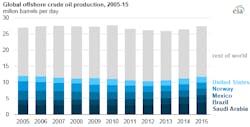EIA: Offshore crude oil production hit five-year high in 2015
Offshore staff
WASHINGTON, D.C.– Global offshore oil production in 2015 was at the highest level since 2010, and accounted for nearly 30% of total global crude oil production, according to the US Energy Information Administration (EIA).
Offshore oil production increased in both 2014 and 2015, reversing consecutive annual declines from 2010 to 2013. Production from onshore tight oil plays has increased faster over the past several years and accounts for an increasing amount of total oil production.
More than 27 MMbbl were produced offshore in 2015 in more than 50 different countries. Global crude oil production is expected to remain high in 2016, as many oil producing nations continue to increase production. In 2015, five countries provided 43% of total offshore oil production: Saudi Arabia, Brazil, Mexico, Norway, and the US.
The world’s largest offshore producer is Saudi Arabia, which has several large oil fields, includingSafaniya, which produces between 1.1 and 1.5 MMb/d and is the highest-producing offshore field in the world. The country is responsible for 13% of the world’s total offshore production.
Brazil’s offshore production grew by 58% between 2005 and 2015, making it the second-largest producer in 2015. This growth was driven predominately by the expansion ofdeepwater presalt projects, which should support small production increases in 2016 and 2017.
The third-largest offshore producer, Mexico, has seen increasingly smaller yields from its assets, with production falling by 31% from 2005 to 2015. The country has still produced nearly 2 MMb/d of offshore crude oil in 2015, accounting for 7% of the global offshore production total.
Although Norway’s offshore production declined 28% from 2005 to 2010, it has remained steady since 2010, with 7% of global offshore production originating from its fields. Norwegian output is forecast to rise slightly in 2016 and to fall slightly in 2017.
Recent strong production in theGulf of Mexico has increased offshore production. From 2005 to 2015, total offshore production grew by 6.5%. With several large projects coming online in 2016 and 2017, the GoM is expected to see production climb by about 0.1 MMb/d in 2016 and then by an additional 0.2 MMb/d in 2017. By contrast, US onshore production is expected to fall by 0.8 MMb/d in 2016 and by an additional 0.3 MMb/d in 2017.
The EIA reported in February that crude production in the GoM is estimated to increase to record high levels in 2017, even asoil prices remain low.
Most offshore production is in shallow-water, which are cheaper and less technically challenging, but there has also been a move toward deepwater projects, the agency said. Exploratory drilling in deeper water is more costly and complex for companies, but technology advancements and the exhaustion of shallower prospects have led companies to explore increasingly deeper waters, particularly in Brazil and in the Gulf of Mexico.
10/25/2016
